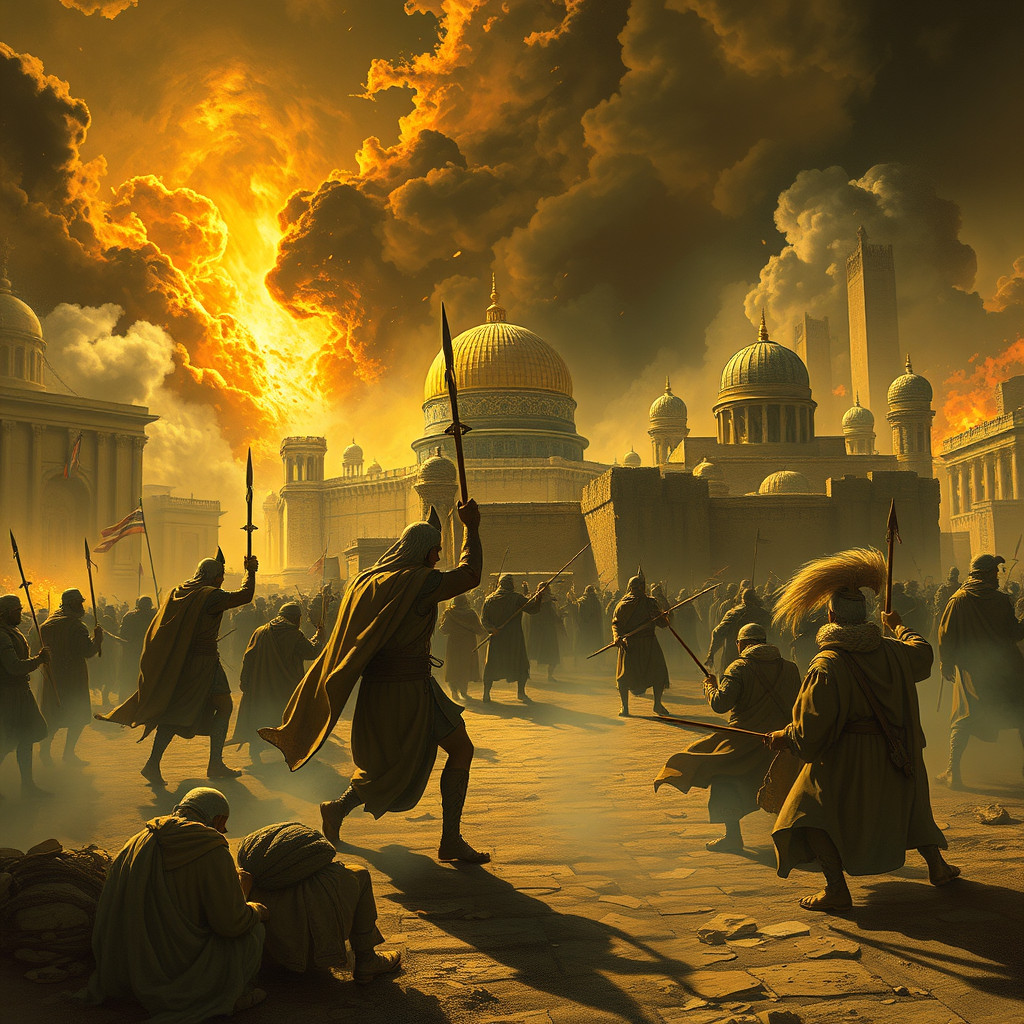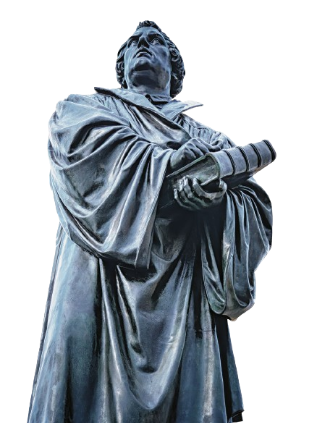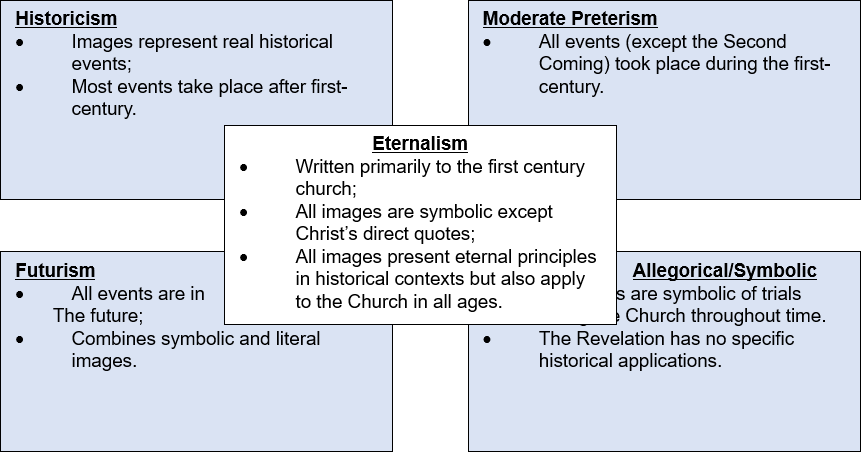
Five Traditional Approaches to the Revelation

Full or Radical Preterism
In this view, all events portrayed in the Revelation have already taken place. Jesus’ Second Coming is seen to have been fulfilled in the Spirit-filled Church moving out into the world as the Body of Christ.
Preterism takes its name from the Latin praeteritus, meaning that which is past. There are two schools of preterist theology: Full (also labeled, radical, or hyper-preterist), and moderate. Full preterists such as James S. Russell, David B. Curtis, John Noe, Max King, and John Bray maintain that everything foretold by John’s vision took place in or about A.D. 70, culminating with the destruction of Jerusalem. The antichrist, the second coming of Jesus, rapture (the catching up), resurrections, and the judgment day – everything predicted in Matthew 24 and in John’s vision – was fulfilled at that time, either spiritually or literally. For example, Jesus’ second coming was manifested in the Church as the Body of Christ. Christ lives in the Church and will be with it forever1.
Full or radical preterists say that the Resurrection of the Dead happened in A.D. 70. They claim this happened when Christ emptied Hades and took the saved to glory in heavenly bodies; The old heaven and earth was the world of Old Covenant Judaism and was replaced by a new heaven and earth, or the New Covenant world. The world we live in will never be destroyed but will continue without end, with the cycle of birth, death, and resurrection enduring forever.2
Moderate (Partial) Preterism
These scholars also believe that most of the Revelation was fulfilled during the first century AD. However, they maintain that The Second Coming of Christ and the Final Judgment are literal and are yet to take place.
While the writings of radical preterists are largely ignored by many respected theologians, moderate preterist views are more acceptable. Moderate preterists hold that, while most of the events in the vision took place during and shortly after John’s generation, the final chapters of the apocalypse have yet to unfold in the literal second coming of Christ and the final judgment.
Moderate preterism usually dates the writing of the Revelation pre-A.D. 70. These commentators point out many details in the Apocalypse, which seem to have been accurately fulfilled in the fall of Jerusalem, the eventual crumbling of Rome under barbarian leadership, and anticipation of the second coming of Christ. They maintain that John’s vision warned his contemporaries of coming tribulations and was meant to encourage the first-century saints by declaring the eventual victory of good over evil, just as one would expect from an epistle addressed to a specific readership. They also point to Jesus’s predictions in the so-called “Little Apocalypse” found in Mark 13:1-31, taking special note of verse 30 (also, Matthew 24, and Luke 17 and 21).
Moderate preterists believe that Jesus was speaking directly to his disciples about things to come during some of their lifetimes. This prophecy so closely resembles the message given to John in his vision that they believe it reasonable to assume that the destruction of Jerusalem in A.D. 70 was the direct subject of both prophecies.

The ancient historian Eusebius, after reading Josephus’ description of the destruction of Jerusalem in A.D. 70, wrote:
“It is fitting to add to these accounts the true prediction of our Savior in which he foretold these very events. His words are as follows: ‘Woe unto them that are with child, and to them that give suck in those days! But pray ye that your flight be not in the winter, neither on the Sabbath day.
For there shall be great tribulation, such was not since the beginning of the world to this time, no, nor ever shall be’ .” Eusebius, History of the Church, Book III, Chapter VII – Matt 24:19-21
This quote indicates that Eusebius believed these Biblical passages predicted the fall of Jerusalem, just as preterists do, though he did not extend the application to the entirety of the revelation.
An early sixth-century commentary on the Revelation, written by Andreas of Cappadocia3, still exists. He wasn’t a preterist himself but commented on some who were. Referring to Revelation 6:12, and later to Rev 7:1, he wrote:
There are not wanting, those who apply this passage to the siege and destruction of Jerusalem by Titus. These things are referred by some to those sufferings which were inflicted by the Romans upon the Jews.
Another sixth-century writer, Arethas of Caesarea4, wrote regarding Rev 6:12 and 7:1:

Some refer this to the siege of Jerusalem by Vespasian… Here then, were manifestly shown to the Evangelist what things were to befall the Jews in their war against the Romans, in the way of avenging the sufferings inflicted upon Christ.
Arethas then reflects on Rev 7:4:
When the Evangelist received these oracles, the destruction in which the Jews were involved was not yet inflicted by the Romans.
Historicism
Historicism is a method of interpreting Revelation that associates its prophecies with actual historical events and identifies symbolic images with historical persons or societies. Historicists seek to establish a straight line of historical events, starting with Daniel‘s prophecies, through John’s Revelation, all the way to the Second Coming of Christ.

Historicists theorize that Revelation encompasses the whole of Church history, from Paul and other disciples’ establishment of the Church to the future Second Coming of Christ. Therefore, its prophecies have been and are being fulfilled in identifiable historical events.
Joachim of Floris (1130-1201) formed the earliest known theory of postmillennialism, the concept that Christ’s Second Coming will follow a literal one-thousand-year period of unprecedented church expansion, spiritual growth, and political peace and prosperity. A great many Franciscan monks, especially in Paris, embraced his historicism. Although Joachim was loyal to the Pope, many who followed his methods of historical interpretation became Protestants and began to see Revelation’s beast, antichrist, and other images as representative of the Papacy and the Roman Church. The Reformers enthusiastically adopted the historicist interpretation in their arguments against the Pope, and for centuries, this approach was the traditional Protestant view of John’s vision5.

Martin Luther (1483-1586) was another influential commentator who saw Revelation chapters 4-22 as a prophetic survey of church history. His approach was adopted by virtually all of the reformers who followed well into the nineteenth century.
The historicist view continued into the 20th century, but according to Gregg, “The only modern commentaries that espouse this view have not come from well-known or credentialed scholars (not that this fact should disparage any view), but from essentially self-published authors who are desirous of reintroducing this viewpoint to a modern readership.”6
A significant weakness of the historicist approach is that scholars disagree on which historical events correlate to John’s images. For example:
- The Antichrist has been seen to be the Papacy, Napoleon, Hitler, and other despots;
- The trumpets have been declared to introduce events such as barbarian invasions of the Roman Empire, Attila the Hun, Genghis Khan, the world wars, and other calamities.
- The vials (bowls) poured out could represent the pandemic of the black death, polio, HIV, or the coronavirus.
Moses Stuart, a preterist, charged that “Hitherto, scarcely any two original and independent [historicist] expositors have been agreed, in respect to some points very important to their bearing upon the interpretation of the book.”7 However, this same argument could apply to some degree to other approaches as well.
Problems can also arise when historicist writers mix symbolic interpretations with literal ones. To one writer, the dragon of chapters twelve and thirteen is a symbolic image, but the newborn child of the same chapters is literally Jesus. To some, the 200 million warriors of chapter nine are literally the Chinese army attacking Europe, but the locusts with hair, breastplates, teeth, and stingers that precede them symbolize tanks and aircraft. Few historicist writers agree on any one symbol.8
Idealism (Allegorical or Symbolic)
This view maintains that none of what John sees is literal. The entirety of the revelation symbolizes the struggle of good versus evil throughout the ages.
The Idealist (also called non-literal, poetic, or dramatic) interpretation spiritualizes the entire revelation. This method sees John’s vision as entirely symbolic and claims the vision never deals with actual historical events. Instead, it symbolizes the spiritual struggles of the Church – the battle between good and evil – through all ages of time.
This view received wide acceptance in the first part of the twentieth century. In 1939, William Hendriksen published his book More Than Conquerors, which immediately became a popular approach to interpreting the Revelation.
William Milligan (15 March 1821 – 11 December 1893), a renowned Scottish theologian, is also credited with the contemporary emergence of this view, observing that:
The beast may be interpreted as the demon-influenced government opposition to the church in any age, and the whore could represent the compromised church or the seduction of the world. While the Apocalypse thus embraces the whole period of the Christian dispensation, it sets before us within this period the action of great principles and not special incidents.9
Unfortunately, a purely allegorical approach denies the Book of Revelation any specific historical fulfillment. The revelation itself declares that it’s a prophecy of events that must shortly come to pass. These repeated affirmations seem to set the Apocalypse in real-time with some historical context. For this reason, Modified Idealism or Eternalism endeavors to combine the symbolic elements of the vision with some historical framework.
Futurism
Scholars of the Futurist school believe that most of the events portrayed in Revelation are to be interpreted literally and are still to come in our future. Futurists generally assign everything after chapter four to a relatively short period in the future, just before the Second Coming of Christ.
The seeds of the futurist view’s beginnings are found in Spanish Jesuits, who attempted to present an alternative interpretation to the historicist claim that the antichrist was the Pope. To the futurist Jesuits, the antichrist was a future being operating in an evil Babylon—a Roman-style government of the future.10
One of the most influential futurist papers was written in 1920 by J.A. Seiss. His Lectures on the Apocalypse continue to find preeminence among modern readers, mainly because of publications like Hal Lindsey’s popular book, The Late Great Planet Earth, Robert Anton Wilson’s, The Illuminati, and the Left Behind series of books and movies by Tim LaHaye and Jerry B. Jenkins.
The futurist view has so dominated the Christian media in recent years that many Christians, and arguably few non-Christians, are unaware of any alternative approaches, assuming that the futurist view is the only interpretation of John’s vision.
The futurist’s perspective on Revelation mixes literal and symbolic interpretations. If the huge hailstones of 16:21 are literal, so must be the stinging locusts (9:3) and beasts with multiple heads (12,13,17). In the search for literal fulfillment, futurists tend to embrace any significant news event that seems to fulfill a portion of John’s vision literally. One such news story was posted by the Associated Press on April 28, 1964, which reported the Red Chinese could field hundreds of millions of soldiers. This corresponded nicely to Rev. 9:16, “The number of the mounted troops was twice ten thousand times ten thousand…”

In addition, the images in Revelation 16:20, Every island fled away and the mountains could not be found, seems to be confirmed by the predicted results of global warming, with melting ice caps and rising sea levels.
While futurists predict that many verses in the vision will be literally fulfilled, other verses are explained symbolically. For example, if the armies of Revelation Chapter 9, which consist of 200,000,000 soldiers released by the fifth trumpet, are a literal force intended to slaughter and terrorize the world, then do they also literally ride horses that have the heads of fire-breathing lions and tails resembling stinging scorpions?
The futurist approach makes it necessary to combine symbolic and non-symbolic interpretations, which places the study of the Book of Revelation on thin ice. It forces readers to choose between literal and symbolic explanations, making it difficult for them to agree and reach a common understanding. While futurists prefer to view all the events of Revelation as literal, many of John’s images appear unavoidably symbolic.
The futurist’s view contains some of the same weaknesses of historicism. If there is no standard method of interpretation, no two readers of Revelation can logically come to the same conclusions, and thus, there can never be a consensus of understanding and unity of faith (Eph 4:13).
Another aspect to consider when applying the futurist approach is that if all or most of John’s vision takes place in our future, the revelation becomes irrelevant by 2000 years or more to the readership to which it was initially intended. Why would Jesus address the saints of Asia Minor concerning things that would have nothing to do with them yet declare repeatedly that those events, …must shortly come to pass (1:1)?

Many question the very origin of the futurist’s method of interpretation. Much like the historicist view, some scholars maintain that futurist interpretations begin as a Catholic rebuttal of the Reformation. In 1585, Francisco Ribeira, a Spanish Catholic Jesuit, seems to have developed the futurist approach as a defense against the Reformer’s historicist claim that the papacy was the beast of chapter 13 and the Roman Church, the prostitute of chapter 17. Because of this, Protestants rejected Ribeira’s view for over 200 years. In 1827, Samuel Maitland re-introduced the futurist concept into Protestant readership, and it was further popularized by the writings of Dispensationalist founder J.N. Darby, beginning in 1830. It was set in stone by twentieth-century books and movies.
Modified Idealist Approach and Eternalism
Eternalism or Modified Idealism most effectively embraces the timeless nature of our Creator. Eternalism sees everything related to God as eternal – His Character, His Words, and His Purposes. Everything God has done or will do, even if related to specific historical events, contains eternal principles that hold true throughout time.
Eternalism identifies the images John sees as symbolic representations of events that would soon confront the ancient Church, as well as defining principles that apply to the spiritual stand of believers at any point in history. Eternalism embraces the direct quotes by Jesus in Revelation as literal and, by their very nature, eternal, maintaining that God not only sent John to console and encourage the infant Church, but the same words apply to all believers at all times. Even though God’s children may be hounded, persecuted, or made destitute, theirs will be the ultimate victory. This concept allows that some of the events John sees, such as Christ’s Second Coming, are still in the future, which, in itself, contains timeless spiritual principles. Eternalism’s relationship to the other four approaches is illustrated below:

An example of the eternal nature of God’s Word to His people can be seen in the travesty of persecution. The infant Church was warned about the coming trials and oppression she would endure11. It’s widely accepted that between the years 60-325 AD, 150,000 to 250,000 Christians may have been martyred during the great Roman persecutions. Those same warnings ring true today. According to Open Doors’ 2021 World Watch List12, a report that identifies the 50 countries where it’s most challenging to be a Christian:
- Every day, at least 12 churches or Christian buildings are attacked;
- Every day, a dozen or more Christians are unjustly arrested or imprisoned;
- An estimated 5,678 Christians were killed in Nigeria from October 2019 to September 2020;
- An estimated 150,000 Christians in India were denied aid during the COVID-19 pandemic because of their faith.
- Aid to the Church In Need (ACN)13, a Catholic charity, reports that almost 340 million Christians around the world—or 1 out of every 8—live in a country where they suffer some form of persecution, such as arbitrary arrest, violence, a full range of human rights violations, and even murder.
- ACN’s two biennial reports, “Religious Freedom in the World” and “Persecuted & Forgotten” puts the number of Christians murdered for their faith in 2018 at more than 4,000 and reports that at least 11 Christians are killed every day in the 50 worst-offending countries.
- The charity’s reports show a fall in the number of murdered Christians during the period from June 2015 to June 2017, but the level of violence aimed at Christians remains severe. For example, a mass killing of Christians happened in Sri Lanka when, on Easter morning in 2019, some 150 Christians died in strikes by suicide bombers at three churches.
- An article series in Christian History magazine reports that a “global war” is being waged against Christians14. The reports are in the latest edition of the quarterly publication and co-authored by members of Voice of the Martyrs USA. Research shows that Christian persecution is most sharply on the rise in South and East Asia, in countries like Myanmar, India, Pakistan, China, and North Korea.
Another example of Eternalism is illustrated in Rev 17:1-18, where the “great prostitute” is identified as …the great city that rules over the kings of the earth (verse 18), which in John’s day was Rome. But the eternal principle expressed is that any corrupt and Godless political entity that opposes Christ’s Church fulfills the image of a great prostitute – a false and unfaithful “bride”15 that will eventually face God’s judgment.

The “horsemen” of chapter six symbolically address some of the consequences facing the pagan world of the first century because of their rebellion against God. But those same consequences, famine, war, pestilence, and death, always come as a result of mankind’s lustful pursuit of riches and power. That principle can be seen:
- On an individual level, if I selfishly seek power and fortune without regard to truth, integrity, and the harm I cause to those around me, I will inevitably suffer famine of relationship, enmity (war) with others, and the death of spiritual values and morals.
- On a corporate level, any business that dishonestly and ruthlessly seeks gain will eventually experience corruption, the destruction of other businesses, and harm to individuals.
- On a national level: When, in pursuit of power and wealth, countries attack other countries, the inevitable results will always be terrible suffering, disease, death, and displacement. And those who suffer most are its citizens and the innocent population of those other lands that are being overrun and exploited.
Scholars throughout the ages have tried to assign specific historical instances to some of the images of Revelation. For example, 5th-century Western Europe had an adversary so terrifying that the very mention of his name haunted the continent for generations. Attila the Hun, ruler of the Hunnic Empire, was renowned for his cruelty, barbarism, and savagery, and Bible scholars throughout Europe and the East saw in him the fulfillment of Revelation’s “beast” and “Anti-Christ.”
The Mongol army under Genghis Khan slaughtered millions of people, and Napoleon brought Europe to its knees. The First World War that saw nearly 40,000,000 casualties was surely “Armageddon,” but it soon led to an even greater apocalypse, the Second World War, where an estimated total of 70–85 million people perished, or about 3% of the estimated global population of 2.3 billion in 194016. Hitler was heralded by many to be the anti-Christ and his Third Reich the “Great Whore of Babylon!”
Many Christians believe that the restoration of the Jewish state of Isreal in 1948 was a fulfillment of prophecy that heralds the beginning of the end times, quoting verses such as the following:

Gen 15:17 When the sun had set and darkness had fallen, a smoking firepot with a blazing torch appeared and passed between the pieces.
Gen 15:18 On that day the LORD made a covenant with Abram and said, “To your descendants I give this land, from the Wadi of Egypt to the great river, the Euphrates…
Gen 17:7 I will establish my covenant as an everlasting covenant between me and you and your descendants after you for the generations to come, to be your God and the God of your descendants after you. 8 The whole land of Canaan, where you now reside as a foreigner, I will give as an everlasting possession to you and your descendants after you; and I will be their God.”
Deut 28:1 If you fully obey the LORD your God and carefully follow all his commands I give you today, the LORD your God will set you high above all the nations on earth.
Ezek 36:26 I will give you a new heart and put a new spirit in you; I will remove from you your heart of stone and give you a heart of flesh. 27 And I will put my Spirit in you and move you to follow my decrees and be careful to keep my laws. 28 Then you will live in the land I gave your ancestors; you will be my people, and I will be your God.
Others point to the same verses and maintain that the promises were contingent on Israel “carefully following all his commands,” which, sadly, they did not. If they had been obedient, their presence in the land would have been permanent. Jerusalem would have continued to be the center of the covenant promise fulfilled in Jesus Christ. Consequently, the promise was transferred to the Jews and Gentiles who accepted Jesus:
Matt 21:43 “Therefore I tell you that the kingdom of God will be taken away from you and given to a people who will produce its fruit.
This study is not meant to challenge any literal interpretation of John’s vision. Instead, it emphasizes that many of those interpretations can be questioned as speculation, while their spiritual applications are widely acknowledged and can impact any age. For instance, every generation perceives frequent global catastrophes as manifestations of John’s vision. However, there has never been a consensus among believers regarding the identity of the anti-Christ (Rev 16, 19, 20; 1-2 John), the nature of the beast (Rev 11, 13, 14, 16), the meaning of the number 666 (Rev 13), or the representation of Babylon (Rev 14, 16, 17, 18). Throughout generations, history often seems to be descending into greater moral decay, with many individuals and circumstances fitting those descriptions. Nevertheless, most Christians can agree on the Biblical eternal principles represented in John’s vision, and ultimately, those eternal truths hold more significance than historical contexts.
Many Christians see the return of the Jews to Israel after 1948 as the fulfillment of Bible prophecy and a sure sign of the end times. There very well could be a time when all believers agree on the rise of a final great anti-Christ personality. While readers can only speculate on the meaning and timing of those events, all believers can agree on the Biblical eternal principles represented by John’s vision, and those eternal truths are ultimately more important than specific historical circumstances.
This study of the Book of Revelation will proceed under these defining premises of Eternalism:
- John’s revelation was meant to be understood.
- Eternalism presents a firm foundation for understanding the sweeping significance of the Apostle’s vision in every age.
- There are four essential keys that can be employed to explain John’s images:
- Identify common expressions and understandings that are familiar to John’s culture as well as our own. For example, we might use the images of a lion, earthquake, and fire, much like the ancient prophets did, in expressions such as:
- “Jason was as bold as a lion when he faced his opponent!”
- “The small community was shaken like an earthquake when they heard the news!”
- “His confidence grew wings and he soared on to new discoveries!”
- “Her convictions raged within her like a refiner’s fire!”
2. Explore Old Testament prophetic images that are very similar to those used in the Revelation. For example:
- Lion –Gen 49:9 – You are a lion’s cub, Judah; you return from the prey, my son. Like a lion he crouches and lies down, like a lioness—who dares to rouse him?
- Beast – Psa 73:22 – I was senseless and ignorant; I was a brute beast before you.
- The color white – Isa 1:18 – Though your sins are like scarlet, they shall be as white as snow; though they are red as crimson, they shall be like wool.
- Earthquake – Nah 1:5 – The mountains quake before him and the hills melt away. The earth trembles at his presence, the world and all who live in it.
3. Christ’s direct comments to John – There are passages within the Revelation where Christ addresses John directly. The intent of these passages is clear and no other interpretation is needed . For example:
- Rev 1:11 – Write on a scroll what you see and send it to the seven churches: to Ephesus, Smyrna, Pergamum, Thyatira, Sardis, Philadelphia and Laodicea.”
- Rev 1:17-19 – Do not be afraid. I am the First and the Last. 18 I am the Living One; I was dead, and now look, I am alive forever and ever! And I hold the keys of death and Hades. Write, therefore, what you have seen, what is now and what will take place later.
4. The interpretation is given in the text: For example:
Rev 1:20 The mystery of the seven stars that you saw in my right hand and of the seven golden lampstands is this: The seven stars are the angels of the seven churches, and the seven lampstands are the seven churches.
Footnotes
- Noe, Top Ten Misconceptions about Jesus’ Second Coming, pgs. 29-43. ↩︎
- Cottrell, Jack, “The Preterist View of Christ’s Second Coming,” http://jackcottrell.com. Accessed March 23, 2018. ↩︎
- His principal work is a commentary on the Book of Revelation (Patrologia Graeca, vol. 106, cols. 215–458 and 1387–94) and is the oldest Greek patristic commentary on John’s Revelation. ↩︎
- Arethas of Caesarea (c. 860 – c. 939) was Archbishop of Caesarea Mazaca in Cappadocia (modern Kayseri, Turkey). He is considered one of the most important theologians of the Greek Orthodox Church. His writings and commentaries preserved many ancient texts, including those of Plato and Marcus Aurelius’ “Meditations”. ↩︎
- Walvoord, John F., The Revelation of Jesus Christ, Moody, Chicago, Ill. 1966, p. 18. ↩︎
- Gregg, Steve, Revelation: Four Views. ↩︎
- Bruce, Frederick F., Revelation, The International Bible Commentary, 1986, p.1595. ↩︎
- Ibid., p. 33. ↩︎
- Milligan, William, The Book of Revelation, p. 153. ↩︎
- Gregg, p. 32. ↩︎
- Matt. 5:10-12, 44; John 5:16, 15:20; Rom 12:14; 2 Tim 3:12; Acts 7:52, 8:1, 13:50, Rev 2:10. ↩︎
- Open Doors is a Christian organization whose goal is to strengthen Christians wherever they are threatened for their faith in Jesus. Its founder was Brother Andrew (“God’s Smuggler”). Open Doors brings support and help to Christians in more than 60 countries. ↩︎
- Founded in 1947, Aid To The Church In Need (ACN) is a Catholic charity serving suffering and persecuted brothers and sisters around the world. ↩︎
- Cath Martin, June 25, 2014, Christianity Today. ↩︎
- An obverse of the true bride of Christ, his Church (Matt 25; Mark 2:19-20; Luke 5:34-35; John 2:9, 3:29). ↩︎
- World War Two Casualties, https://www.worldwar2facts.org/world-war-2-casualties.html ↩︎







